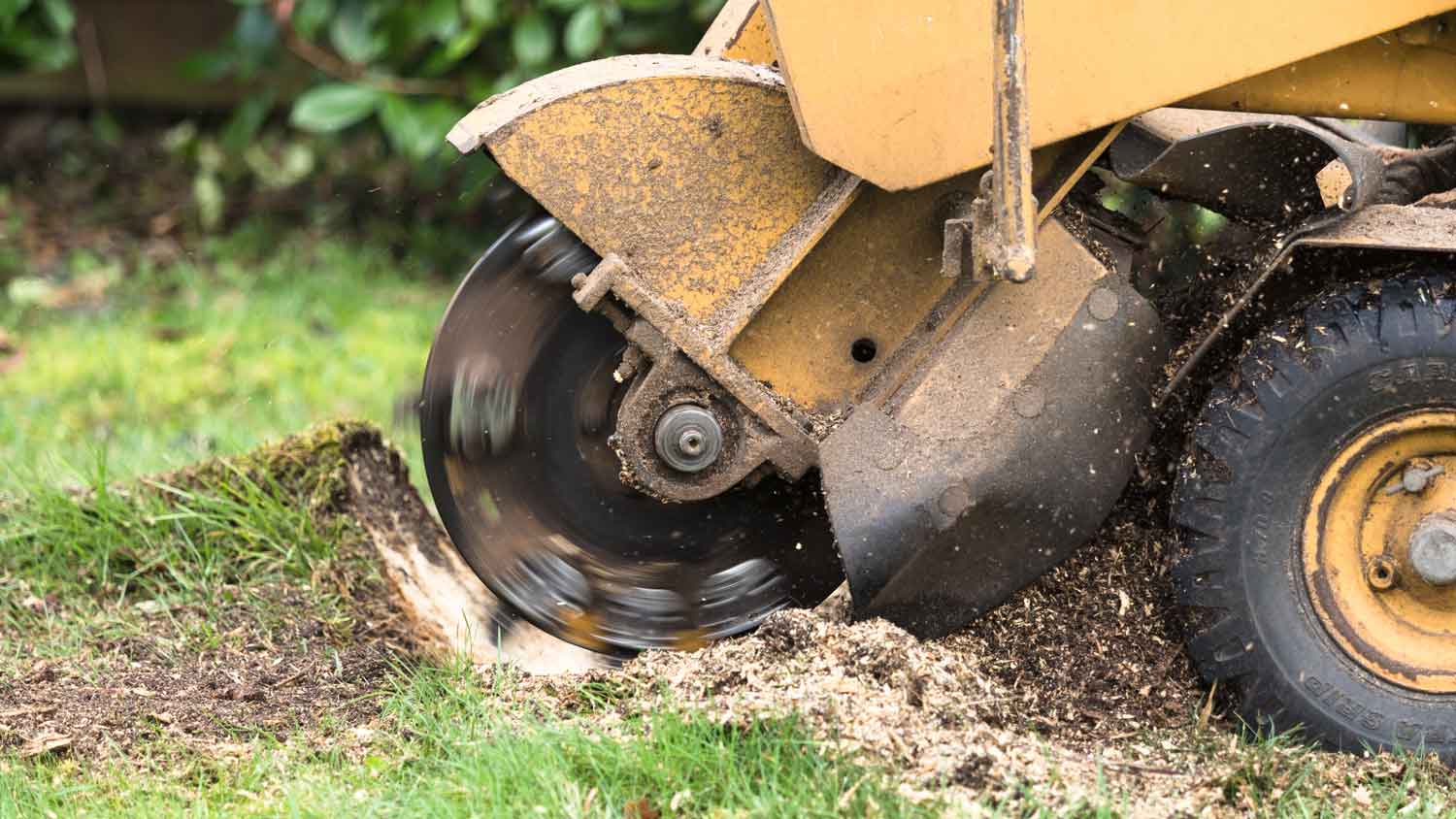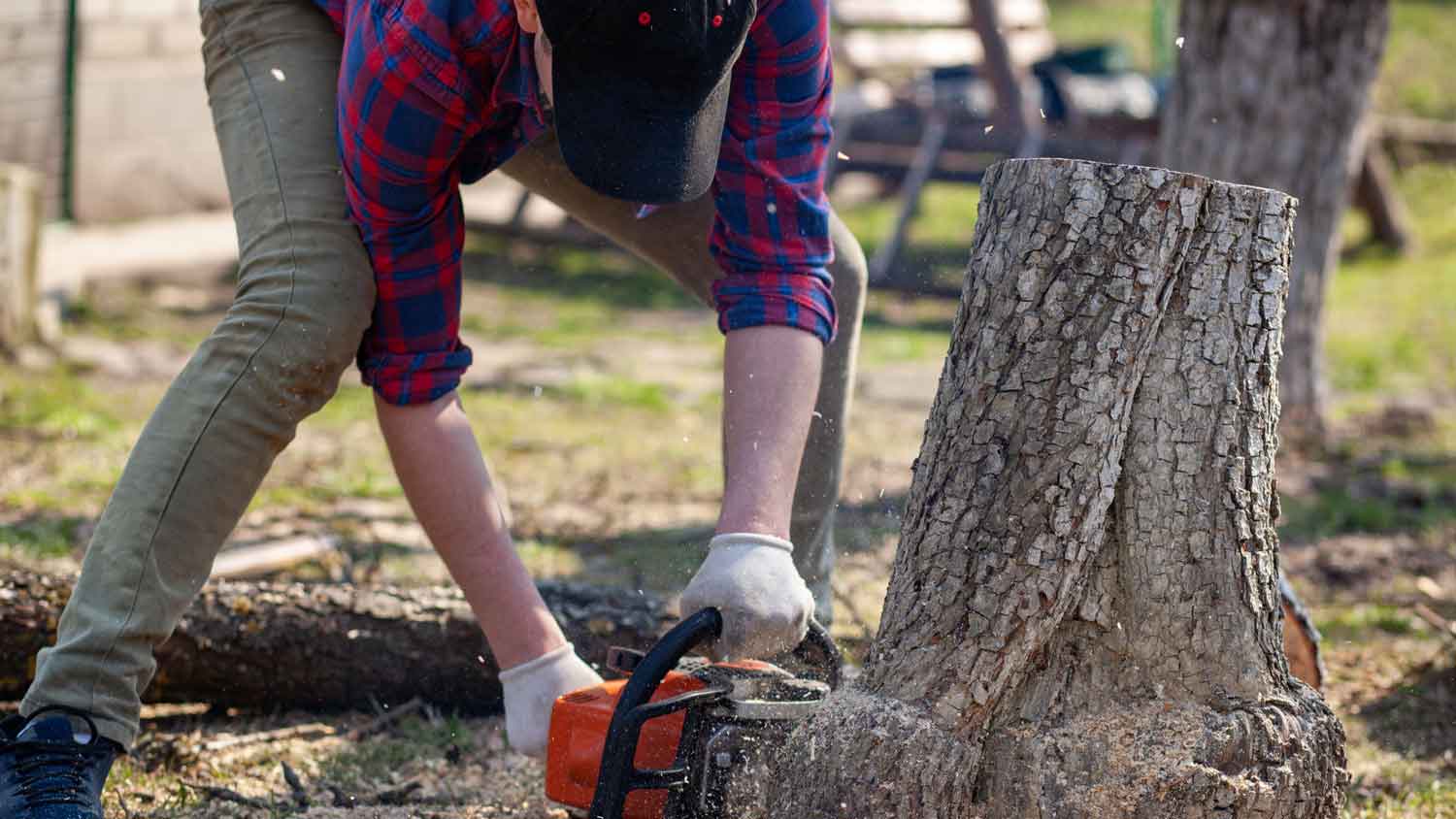
Find out how much it costs to plant a tree based on the number of trees, their size, where you want to plant them, and DIY versus professional costs.
Stumped on what to do? Read on.


Stump grinding costs about $320 on average, while stump removal costs about $360.
While stump grinding is often safer and less disruptive, this removal method may cause long-term complications.
The land recovery is better post-stump removal, as stump grinding makes the area unusable for new trees, foundations, or patios.
Stump removal is more time and labor-intensive than stump grinding, including filling the large hole with soil and hauling away tree debris.
There are a few ways to remove a tree stump, but your two main options are grinding and removal. Both have benefits and drawbacks, depending on your budget and what you hope to do with the space afterward. If you’re stumped on which is right for you, compare stump grinding vs. stump removal so you can spruce up your yard.

Once a tree has been cut down, you can either have the stump ground down or removed completely. The route you choose depends on how you intend to use the area, your budget, and the job's complexity.
With stump grinding, a professional tree trimming service will use a machine with a rotating disk to grind the remains of the tree into small wood chips. Stump grinding is generally less expensive than stump removal and even provides you with natural mulch that you can use in the rest of your yard. However, it will likely leave roots behind, so if you want no remaining evidence of a tree, it may not be your best option.
A pricier process, stump removal includes extracting the roots and the stump from your yard so that no tree remnants are left. This is especially beneficial if you use the space for landscaping or construction purposes. However, just know going into it that stump removal is more labor-intensive and time-consuming than stump grinding, so it’s a process that likely won’t happen overnight.

Stump grinding is a process arborists or tree removal experts use to remove stumps after a tree has fallen or been cut down. Professionals use a machine called a stump grinder to cut the stump down into small chips that can later be used as mulch. Stump grinding removes the visible part of the stump but does not get rid of the tree’s roots beneath the surface. It’s often a more efficient and cost-effective way to reduce the visibility of a stump.
| Pros | Cons |
|---|---|
| Less expensive | Doesn’t remove roots |
| More efficient | Heavy cleanup |
| Eco-friendly | Can lead to pests |
Stump grinding is a fairly simple process that suits those with tighter budgets and timelines.
More affordable: Stump grinding costs between $170 and $500, depending on how tall and wide the stump is. For smaller stumps, it’s usually quite a bit less expensive to grind instead of remove.
Safety: Stump grinding requires less grueling manual labor, which reduces the risk of serious injury. Grinding is safer for surrounding plants and wildlife, as it doesn’t require heavy machinery or toxic chemicals.
Less disruptive: Since stump grinding doesn’t remove a tree’s root system, the process won’t cause major disruption to your yard. You’ll only have to worry about cleaning up wood chips when the job is done.
Faster turnaround: Stump grinding can be done much quicker if time is of the essence. Stump removal is a much more involved project, requiring the removal of roots and the implementation of chemicals.
Immediate hole filling: Stump grinding automatically fills that hole with stump chips that will decay over time. If you don’t want to wait long, you can remove all the chips and fill the hole with soil.
Although it’s a more budget-friendly option and can be done quickly, stump grinding is cheaper for a reason. Notably, you’ll still be left with evidence of the tree on your property.
Less attractive: A grinded-up stump can be somewhat unsightly, which may affect your property value.
Unusable space post-project: You can’t successfully plant new trees or safely build a foundation or patio in the same area as a ground stump—meaning that spot is pretty much off-limits after the project.
Potential pest problem: Leaving wood chips and roots may lead to pest issues, like termites or fungi. If termites find the grindings, they could make a colony in them.

Stump removal, on the other hand, takes out the stump and root system completely. It’s more work but might be a better solution for homeowners who plan to hire a local stump removal service.
| Pros | Cons |
|---|---|
| Enhanced land use | More costly |
| Complete solution | Less eco-friendly |
| Avoids regeneration | Thorough process |
Stump removal comes with its benefits, especially if you are looking to put new landscaping or building on the ground that your tree once lived on.
Better for future projects: Removing the roots and filling the space with new soil offers flexibility for future projects, like building a new deck or planting a garden.
More thorough solution: Stump removal takes out the stump and the roots, which means you can be confident that there won’t be any costly surprises down the road—like your foundation.
Prevents regeneration: With complete stump removal, there’s less chance for new shoots or sprouts to emerge, so you won’t have to deal with regeneration down the line.
You may not be able to have a professional perform stump removal if you don’t have the funds for it or if you’re concerned about the impact stump removal has on the planet.
More expensive: It’s more expensive to remove a stump, as the project is much more in-depth. Instead of just removing the surface-level stump, stump removal takes out the roots, too—which surprisingly can equal more than a third of the tree’s total biomass!
May require chemicals: Stump removal may require certain chemicals to speed up the decaying process. There are some more natural ways to kill a tree stump, but they’re not as efficient.
Requires post-project steps: There are many follow-up steps after the removal that make this project a bit more complicated, including filling the hole with soil, hauling the old stump away, and cleaning up chemicals.

It can be difficult to determine when you should grind your stump vs. when you should remove your stump. Here are factors to help you decide what will work best for you.
Stump removal is more expensive than stump grinding. Tree stump removal costs $100 to $200 more than stump grinding, as the process is a lot more involved. Also, the resulting hole is pretty large after removal, which must be filled with soil afterward. With grinding, the hole is automatically filled with stump chips when you grind it down.
With stump grinding, you can’t plant any new trees or build a foundation or patio in the same area, making that spot unusable for the foreseeable future. If you decide to eradicate the stump, you can successfully replant or build in that same area without issue once the soil is filled. If you have big plans for your yard in the future, stump removal is the right choice.
Stump removal is more time and labor-intensive than stump grinding. Plus, after the removal, you’ll be left with many steps to take care of afterward, including filling the large hole with soil and hauling away the old trunk and roots. If you’re looking for a quicker turnaround, grinding will be the best option.
When you leave the roots in place, you also leave a tasty buffet for fungi, pests, and critters to feed on. With stump removal, there is no risk of attracting these pests since the stump and roots are completely gone.
Stump grinding will leave the stump in the ground, eventually decomposing. Stump removal, however, is more invasive and may involve chemical use that can disturb the surrounding soil.
From average costs to expert advice, get all the answers you need to get your job done.

Find out how much it costs to plant a tree based on the number of trees, their size, where you want to plant them, and DIY versus professional costs.

Discover the average tree maintenance cost, key price factors, and tips to save. Get expert insights to plan your tree care budget with confidence.

Get a clear estimate of palm tree maintenance cost, including trimming, fertilization, and pest control, so you can keep your palms healthy and your budget on track.

Trees absorb carbon dioxide, and fight pollution and global warming, not to mention create oxygen, something every living thing needs to survive.

If a tree is growing on your property line, whose responsibility it? Here’s a handy guide to navigating tree care with your neighbors.

A credible tree care company should be licensed, carry insurance, have a certified arborist on staff, and be trained in safe tree removal. Here's what to know.